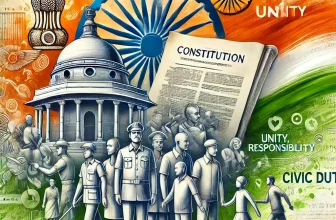The Indian judiciary system is the backbone of the country’s legal framework, ensuring justice, maintaining law and order, and protecting citizens’ rights. However, for many, the legal process—from filing an FIR to reaching a final verdict—can seem complicated and confusing. Understanding the Indian judiciary system is essential for every citizen, as it ensures justice and upholds the rule of law.
This post simplifies the step-by-step journey of a case in the Indian judicial system. Whether you are a concerned citizen, a law student, or someone facing legal proceedings, understanding how the system works will empower you to navigate it more effectively.
1. Filing an FIR (First Information Report)
A. What is an FIR?
An FIR is a written document prepared by the police when they receive information about the commission of a cognizable offense—serious crimes like murder, rape, theft, etc., where immediate police intervention is warranted. It serves as the official record that initiates the criminal investigation process.
B. Who Can File an FIR?
- Victim: The person against whom the offense has been committed.
- Witness: Someone who has seen or has knowledge about the crime.
- Any Other Person: Anyone aware of the offense can report it, even if they are not directly affected.
C. Procedure to File an FIR:
- Approach the Police Station: Visit the police station in the jurisdiction where the crime occurred.
- Provide Information: Narrate the incident details orally or in writing. If given orally, the police will document it.
- Verification and Signature: The recorded information is read back to the informant for verification, and upon confirmation, the informant signs the document.
- Receipt of FIR Copy: A free copy of the FIR is provided to the informant for their records.
D. Key Points:
- The police are obligated to register an FIR if the information pertains to a cognizable offense.
- Delays in filing an FIR can lead to loss of crucial evidence; hence, prompt reporting is advisable.
2. Police Investigation
Once an FIR is registered, the police commence a thorough investigation to gather evidence and establish the facts of the case.
A. Steps Involved:
- Visit to the Crime Scene: Inspecting the location where the offense occurred to collect physical evidence.
- Collection of Evidence: Gathering forensic samples, documents, weapons, or any material relevant to the crime.
- Recording Statements: Interviewing the victim, witnesses, and suspects to document their accounts.
- Arrests: Detaining individuals suspected of involvement in the crime, based on evidence.
- Forensic Analysis: Sending collected samples to forensic labs for detailed examination.
B. Rights During Investigation:
- Accused: Right to legal representation, protection against self-incrimination, and humane treatment.
- Victim: Right to be informed about the investigation’s progress and protection from intimidation.
C. Outcome of Investigation:
- Filing of Chargesheet: If sufficient evidence is found, a formal document outlining the charges against the accused is submitted to the court.
- Closure Report: If evidence is insufficient, the police may file a report recommending the case be closed, subject to the magistrate’s approval.
3. Filing of Chargesheet & Start of Court Proceedings
Once the police complete their investigation, they prepare a chargesheet if there is enough evidence against the accused. This document is crucial as it formally starts the legal proceedings in court.
A. What is a Chargesheet?
- A chargesheet is a comprehensive report detailing:
- The crime committed
- Evidence collected
- List of witnesses
- Statements recorded during the investigation
- Applicable sections of the Indian Penal Code (IPC) or other laws
- It is submitted to the Magistrate Court within 60-90 days (depending on the nature of the case).
B. What Happens Next?
- If the Magistrate accepts the chargesheet, the case moves to trial.
- If the Magistrate finds insufficient evidence, the case may be dismissed or sent back for further investigation.
4. Bail Hearing (If Accused is Arrested)
If the accused has been arrested, they can apply for bail, which allows them to stay out of custody while the trial is ongoing.
A. Types of Bail:
- Regular Bail – Given to an accused already in custody.
- Interim Bail – Temporary bail until a final decision is made.
- Anticipatory Bail – Applied before arrest, for protection in case of false accusations.
B. How is Bail Granted?
- For Minor Offenses (Bailable Offenses): Bail is usually granted easily.
- For Serious Crimes (Non-Bailable Offenses like Murder, Rape, Terrorism, etc.): The court considers factors like:
- The severity of the crime
- The likelihood of the accused fleeing
- Chances of influencing witnesses
- Criminal history of the accused
If bail is denied, the accused remains in judicial custody until the case is decided.
5. Trial in Court (Hearing of the Case)
Once the trial begins, both sides (Prosecution and Defense) present their case in court. The trial is conducted in three stages:
A. Framing of Charges
- The judge reads the charges to the accused, who pleads guilty or not guilty.
- If the accused pleads guilty, the judge may convict them immediately.
- If the accused pleads not guilty, the trial proceeds.
B. Examination of Evidence & Witnesses
- The Prosecution (representing the state) presents witnesses and evidence against the accused.
- The Defense Lawyer cross-examines witnesses to challenge the Prosecution’s claims.
- Both sides submit documentary proof like CCTV footage, forensic reports, medical records, etc.
C. Cross-Examination and Defense’s Turn
- The accused can present their own witnesses and evidence.
- The Defense Lawyer tries to disprove the charges by questioning the credibility of the Prosecution’s case.
6. Final Arguments & Judgment
Once all evidence has been examined, the judge listens to final arguments from both sides.
How is Judgment Given?
- The judge evaluates all witness statements, documents, and legal arguments before making a decision.
- Possible Outcomes:
- Acquittal (Not Guilty): If there is no strong evidence, the accused is released.
- Conviction (Guilty): If proven guilty, the court announces punishment (fine, imprisonment, or other penalties).
7. Appeal to a Higher Court
If the accused disagrees with the verdict, they can appeal in a higher court.
A. Appeal Process:
- District Court → High Court (For serious cases)
- High Court → Supreme Court (Final appeal stage)
B. Grounds for Appeal:
- Unfair trial
- Wrongful conviction
- New evidence that can prove innocence
C. The higher court can either:
- Uphold the original verdict
- Modify the sentence
- Order a retrial
8. Execution of Punishment (If Convicted)
If the accused is convicted, the punishment is carried out as per the court order.
A. Types of Punishment in India:
- Fine – Monetary penalty for minor offenses.
- Imprisonment – Can be for a fixed term (years) or life imprisonment.
- Death Penalty – Given in rare cases (e.g., terrorism, brutal murders).
B. Can a Convicted Person Seek Clemency?
- Yes. If sentenced to death, the accused can appeal for clemency (forgiveness of punishment) to the President of India.
Final Thoughts
The Indian legal system follows a structured approach to ensure justice is served fairly. The process begins with the filing of an FIR, followed by a police investigation and submission of a chargesheet in court. If the case proceeds, the trial begins, with both sides presenting evidence and arguments before a judge. Depending on the outcome, the accused may be acquitted or convicted. If convicted, they have the right to appeal to a higher court for reconsideration.
Each stage of the judicial process is designed to protect both the victim’s rights and the accused’s fair trial rights. By understanding these steps, you gain clarity on how justice is delivered in India and what to expect at each stage of the legal journey.
Justice may take long-long time, but the Indian legal system is built to ensure fairness for all.
source 1- https://www.sci.gov.in/
Source 2 – https://ecourts.gov.in/ecourts_home/static/highcourts.php




